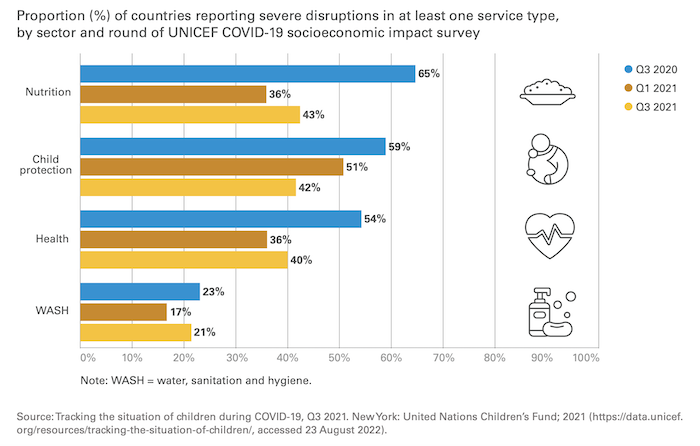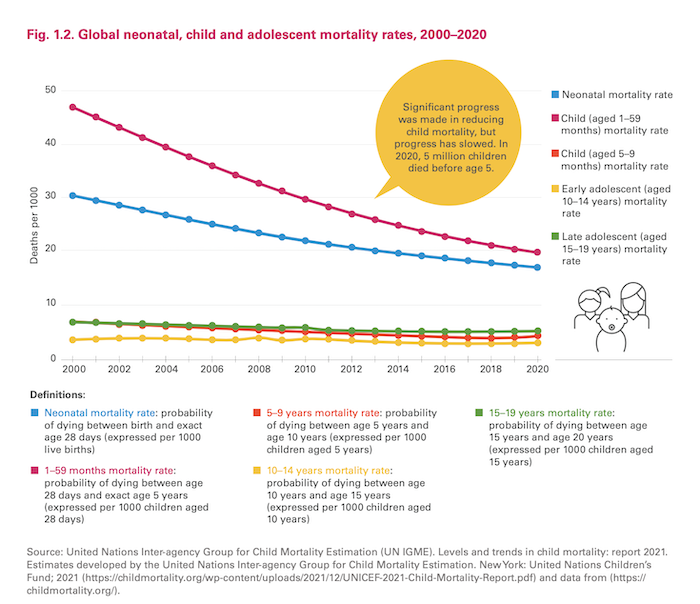Two steps back for the health of women and children in the face of conflict, climate change and COVID-19, report shows

The health of women and children worldwide has been battered in the last two years, a period that has witnessed growing impacts of conflicts, climate change and the ongoing effects of the COVID-19 pandemic, reveals the 2022 Every Woman Every Child Progress Report launched on 18 October. The report, titled Protect the Promise, shows that food insecurity, hunger, child marriage, risks from intimate partner violence, and adolescent depression and anxiety have all increased since the last report released in 2020.
The poor and marginalized – categories in which women and children are disproportionately represented – have fared the worst in most places during the pandemic, and now the growing number of humanitarian crises resulting from conflict and climate change is dragging down attempts at recovery.
“Far from a progress report, this document describes a reversal. Women’s and children’s health and rights are threatened to a degree not seen in more than a generation,” says UN Secretary-General Antonio Guterres. “If these inequities persist, we will not keep our promise for a healthier, safer and more just world for all by 2030. Nor will we be equipped to manage the next pandemic, prevent the next conflict or adapt to the mounting loss and damage from climate-related disasters.”

COVID-19 alone cannot be blamed for the backsliding, points out the report, as the world was already falling behind in achieving key global targets before the pandemic began. For example:
- The global share of pregnant women living with HIV who had access to antiretroviral treatment, vital to keeping them healthy while also preventing their infants and young children from contracting the virus, surged from 46 percent in 2010 to 81 percent in 2015, but six years later in 2021 it was still 81 percent.
- After several years of slow adoption and scale-up, global coverage of the first dose of vaccination against human papillomavirus also fell by five percentage points, from 20 percent in 2019 to 15 percent in 2021, leaving millions of adolescent girls at risk of cervical cancer later in life.
- Despite great progress in cutting maternal and child mortality in the two decades leading up to the pandemic, inequities persist. A child born in a low-income country has an average life expectancy at birth of around 63 years, compared to 80 in a high-income country.
A child’s life trajectory and rights to health, education, opportunities and safety are still largely determined by where that child is born.

Infectious diseases remain the leading causes of death in children under the age of 5, but NCDs and injuries are making a larger relative contribution to child morbidity and mortality. This is due in part to the fact that that women and children who are forced to cross borders or who are internally displaced because of conflict, other forms of instability or natural disasters increasingly related to climate change are also at high risk of poor health and developmental outcomes.
Another factor is that children who are stunted (low height for age) are more susceptible to dying from infections and are predisposed to becoming overweight and to developing diet-related NCDs later in life.
The report also shows that overweight and obesity levels are worsening in almost all parts of the world, further adding to the NCD burden. Around 39 percent of adults globally were overweight in 2016 and 13.1 percent were obese. Among children and adolescents ages 5 to 19, the prevalence of overweight and obesity rose from 4 percent in 1975 to about 18 percent in 2016, with similar rates for girls and boys (18 percent and 19 percent, respectively).
The progress report is published by global partners, including WHO, UNICEF, UNFPA, Partnership for Maternal, Newborn & Child Health and Countdown to 2030. Its recommendations include “strengthening primary health care systems to deliver essential interventions to all women, children and adolescents.”
Priority actions to accomplish are:
- Making primary health care systems ready to deliver the full spectrum of essential health services;
- Building strong community health components to increase service availability and acceptability;
- Conducting implementation research that can generate evidence for tailoring interventions to specific contexts;
- Strengthening health information systems to enable countries to regularly collect, analyse and use high-quality data.